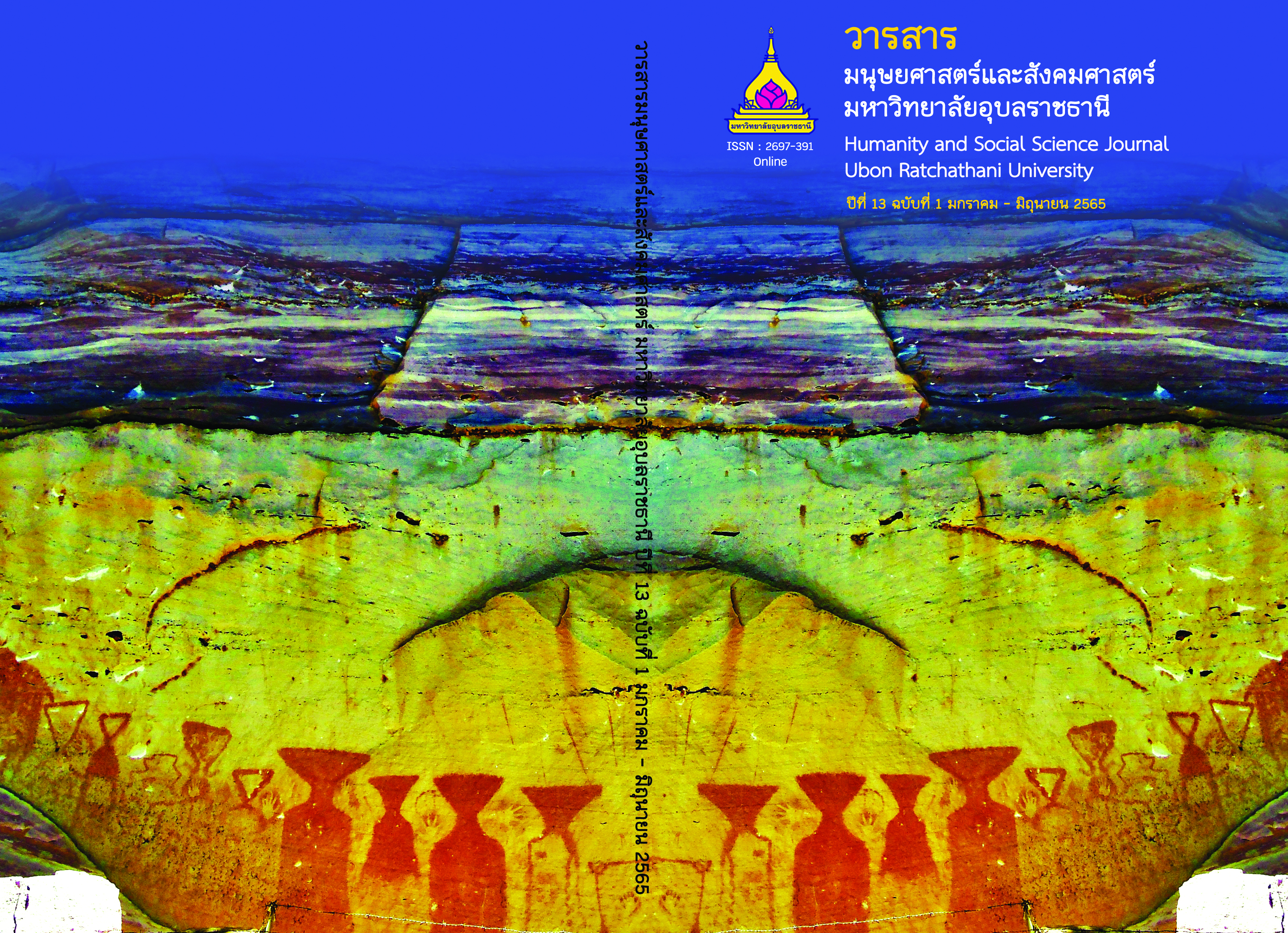การศึกษาภูมิทัศน์ภาษาศาสตร์ของตลาดท่าเสด็จ จังหวัดหนองคาย
Main Article Content
บทคัดย่อ
บทความวิจัยนี้มีวัตถุประสงค์เพื่อศึกษาภาษาบนป้ายสาธารณะและวิเคราะห์หน้าที่ของภาษาที่ปรากฏในตลาดท่าเสด็จ จังหวัดหนองคาย งานวิจัยนี้ ใช้แนวคิดภูมิทัศน์ภาษาศาสตร์ของ Landry and Bourhis ในการวิเคราะห์ภาษาที่ปรากฏและหน้าที่ของภาษา โดยเก็บข้อมูลจากป้ายสาธารณะทุกประเภททั้งป้ายของภาครัฐและป้ายของภาคเอกชนทั้งหมดจำนวน 558 ป้าย ผลการศึกษาพบว่าภาษาที่ปรากฏอยู่ในพื้นที่ตลาดท่าเสด็จมีทั้งหมด 12 ภาษา ภาษาไทยพบมากที่สุดและเป็นภาษาหลักของพื้นที่ รองลงมาตามลำดับคือภาษาอังกฤษ ภาษาจีน ภาษาลาว ภาษาต่างประเทศอื่น ๆ ที่พบ ได้แก่ ภาษาฝรั่งเศส ภาษาเวียดนาม ภาษาญี่ปุ่น ภาษาเยอรมัน ภาษาเกาหลี ภาษาพม่า ภาษาเขมร และภาษาอาฟรีกานส์ ภาษาบริเวณตลาดท่าเสด็จทำหน้าที่ในการให้ข้อมูล มากกว่าหน้าที่ในเชิงสัญลักษณ์ โดยหน้าที่ในการให้ข้อมูลคิดเป็นร้อยละ 67.59 และหน้าที่ในเชิงสัญลักษณ์คิดเป็น ร้อยละ 32.41 ผลการศึกษาสะท้อนให้เห็นว่าตลาดท่าเสด็จเป็นพื้นที่พหุภาษา เนื่องด้วยปัจจัยของพื้นที่ตลาดท่าเสด็จมีลักษณะเป็นพื้นที่การท่องเที่ยว ประกอบกับเป็นพื้นที่ขับเคลื่อนเศรษฐกิจด้านการค้าขาย ส่งออกสินค้าและบริการ จึงมีผู้มาใช้บริการต่าง ๆ จากประเทศเพื่อนบ้าน
Article Details

อนุญาตภายใต้เงื่อนไข Creative Commons Attribution-NonCommercial-NoDerivatives 4.0 International License.
บทความที่ได้รับการตีพิมพ์เป็นลิขสิทธิ์ของวารสารมนุษยศาสตร์และสังคมศาสตร์ มหาวิทยาลัยอุบลราชธานี
ข้อความที่ปรากฏในบทความแต่ละเรื่องในวารสารวิชาการเล่มนี้เป็นความคิดเห็นส่วนตัวของผู้เขียนแต่ละท่านไม่เกี่ยวข้องกับมหาวิทยาลัยอุบลราชธานี และคณาจารย์ท่านอื่นๆในมหาวิทยาลัยฯ แต่อย่างใด ความรับผิดชอบองค์ประกอบทั้งหมดของบทความแต่ละเรื่องเป็นของผู้เขียนแต่ละท่าน หากมีความผิดพลาดใดๆ ผู้เขียนแต่ละท่านจะรับผิดชอบบทความของตนเองแต่ผู้เดียว
เอกสารอ้างอิง
Alomoush, O. L. (2015). Multilingualism in the linguistic landscape of urban Jordan. Doctor thesis in Philosophy. The University of Liverpool.
Backhaus. P. (2006). “Multilingualism in Tokyo: a look into the linguistic
Landscape”. International Journal of Multilingualism, 3(1), 52-66.
Cenoz. J & Gorter.D. (2006). “Linguistic landscape and minority languages”. International Journal of Multilingualism, 3(1), 67-80.
Chan. V. (2008). “The linguistic landscape of a Cambodia town in lowell,
Massachusetts”. Journal of Southeast Asian American Education and Advancement, 13(1), 1-24.
Chansang. A. (2019). “The historical development of Chinese migration
pattern and routes in Mekong sub-region of Northeastern Thailand during the Late 20th- Early 21st Centuries1”. Mekong-Salween Civilization Studies Joural, (1), 14-34. (in Thai)
Crystal. D. (2001). Language and the Internet. Cambridge: The Press
Syndicate of The University of Cambridge.
Edelman. L. J. (2009). Linguistic landscapes in the Netherlands a study of multilingualism in Amsterdam and Friesland. PhD thesis. Amsterdam Center for Language and Communication.
Firth, J.R. (1964). On sociological linguistics. In Dell Hymes. 1972. Language in culture and society. New york: Haper and Row.
Foreign Affairs Division Office of The Permanent Secretary Ministry of Interior. (2019). Summary report of travel statistics in and out of Thailand’ border crossings and neighboring countries. Retrieved October,10 2021, From http://www.fad.moi.go.th/images /Ngancedkumpha/ meena63/ satititpandean.pdf.
Huebner, T. (2008). “Bangkok’ s linguistic landscape: environmental print,
code mixing and language change”. International Journal of Multilingualism, 3(1), 31-51.
Jazul. M. E & Bernardo. A. (2017). A look into Manila chinatown's linguistic landscape: the role of language and language ideologies. Ph.D. Thesis. University of Santo Tomas.
Kaewbut. P. (2019). “Chinese readiness of Surat Thani international airport with mice city: the study of linguistic landscape”. Journal of Humanities Naresuan University, 17(1), 89-104. (in Thai)
Kress. G. (1993). “Against arbitrariness: the social production of the sign as a foundational issue in critical discourse analysis”. SAGE journals, 4(2), 169-191.
Khuboonyaarak. N, Boonchai, P & Boonchai, P. (2561). “The role of
ethnic Thai-Vietnamese people in effecting changes on the Thai economy, society and culture”. Nakhon Phanom University Journal, 8(2), 107–16. (in Thai)
Landry & Bourhis, R. (1997). “Linguistic landscape and ethnolinguistic vitality: an empirical study”. Journal of Language and Social Psychology, 16(1), 23-49.
Rhekhalilit. K. (2020). “Language choice of public signage in Thai universities a case study of Chulalongkorn university and Kasetsart university”. Manutsayasat Wichakan, 27(2), 310-341. (in Thai)
Meemongkol. G. (2021). “Linguistic landscape of soi Nananua and soi Ekamai”. Journal of Humanities and Social Sciences, 21(1), 66-88. (in Thai)
Pachnalawan. P, Munkhong. A & Sethakorn. W. (2017). Three accents of toponym: using Thai, English and Chinese on public signs in Lampang municipality. Local Admonistration Journal, 10(4). 120-138. (in Thai)
Prasert, K & Jimarkon Zilli, P. (2019). “A linguistic landscape analysis of Pattaya, Thailand’s sin city”. Discourse and Interaction, 12(1), 75-95.
Rafael, E.B & Scohamy, E. (2008). “Linguistic landscape as symbolic construction of the public space: the case of Israel”. A linguistic Landscape: A New Approach to Multilingualism, 3(1), 7–30.
Rungswang, A. (2018). “Linguistic landscape: forms and functions of signs in Thai community center, golden mile complex, in Singapore”. TNI Journal of Business Administration and Languages, 6(1), 35-39.
Sarot. T & Kraisame.S. (2019). “Urban multilingualism: a case study of the relationship between linguistic landscape and business in north Nana”. Journal of Language and culture, 38(1), 24-40.
Seangyen, C. (2015). “Linguistic landscape on billboards in Mueang district, Udon Thani province”. Mekhon Chi Mun Art and culture journal, 1(2), 18-34. (in Thai)
Siricharoen, A. (2016). “Multilingualism in the linguistic landscape of the Faculty of Arts, Chulalongkorn university, Thailand”. MANUSYA: Journal of Humanities, (22), 13-22.
Siwina, P & Prasithrathsint, A. (2020). “Multilingual landscapes on Thailand’s
borders”. Journal of Mekong Societies, 16(1), 113-129.
Spolsky, B & Cooper, B. L. (1993). “The languages of Jerusalem”. International Journal Middle East Studies, 25(1), 144-145.
Suaykratok, P. (2018). “Inclusion of the minority language on public signs: multilingualism in the deep south of Thailand”. NIDA Journal of Language and Communication, 24(23), 3-19.
Sutthinaraphan, K. (2016). “A linguistic landscape study of advertising signage on skytrain”. ANUSYA: Journal of Humanities, (22), 54-71.
Thongtong, T. (2016). “A linguistic landscape study of signage on Nimmanhemin road, a Lanna Chiangmai chill out street”. MANUSYA: Journal of Humanities, 22(1), 73-87.
Wangpusit, K. (2019). A comparison of signboard names between two areas of Banglamphu and Siam Square: An analysis of a Linguistic Landscape. Veridian E-Journal, 12(2), 20-35.
Wiriyosutthikul. S, Kulsawat. T & Isariyanon. S. (2015). “Policy and strategy of cultural tourism industry development in Nong Khai Province”. Journal of politics, administration and law, 7(3), 93-123. (in Thai)
Wu, H & Techasan, S. (2016). “Chinatown in Bangkok: the multilingual landscape”. MANUSYA: Journal of Humanities, 22(1), 39-52.


